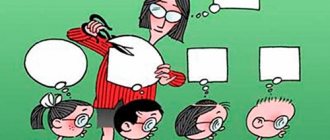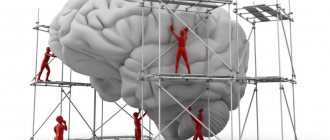Scientific background:
1) criticism of behaviorism and the revival of interest in the topic of consciousness in the United States since the 50s of the twentieth century;
2) the influence of Gestalt psychology - the adoption of the active role of the subject, interest in the problem of consciousness;
3) the teachings of J. Piaget, who conducted a number of significant studies on child psychology from the standpoint of studying the stages of a child’s cognitive development;
4) changing the scientific paradigm in physics - abandoning the idea of absolute objectivity and recognizing the active role of the subject in the cognitive process.
The formation of cognitive psychology:
1) 1960 – the opening by J. Miller and J. Bruner of the Center for Cognitive Research at Harvard; the Center studied various cognitive processes - perception, memory, thinking, speech, including an analysis of their genesis. This was the first use of the term "cognitive";
2) In 1967, U. Neisser published a book called “Cognitive Psychology”. This book opened a new field of research. U. Neisser defined cognition as a process by which “incoming sensory data undergoes transformation, reduction, processing, accumulation, reproduction and is subsequently used... Cognition is present in any act of human activity.” P. Thus, cognitive psychology deals with sensations, perception, imagination, memory, thinking and all other types of mental activity. The computer metaphor expressed in the book Cognition and Reality (1976) formed the basis of works in which computer programs serve as a model for understanding human information processing. Intelligence is not considered as a set of sequential, often loosely connected stages or stages of information processing, as was the case in traditional psychology, in which it was believed that after sensation comes perception, then memory, thinking, etc. The new approach considers a complex system that has a complex structure, and the hierarchy is built on types of information processing and depends on the tasks at hand.
9 pages, 4273 words
Andreeva G.M. — On the problems of the psychology of social cognition
... - a step was taken towards the socio-psychological study of cognitive processes. Social psychology was most poised to become the immediate predecessor of the psychology of social cognition. We can name at least three areas...
Historical reference
Cognitive psychology (cognitio (lat.) - knowledge, cognition) arose in the USA in the 50s of the 20th century. Before the advent of cognitive psychology in its modern form, psychologists were already trying to deal with problems of cognition. Many years (and even centuries) ago there were already the first attempts to study thinking not only by philosophical, but also by scientific methods.
It is believed that philosophers such as Descartes, Hume and Kant played a certain role in the development of modern cognitive psychology. Descartes' idea of mental structure resulted in a research method for studying one's own psyche. The empiricist Hume tried to establish the laws of association of ideas and developed a classification of mental processes. For Kant, reason is the structure, experience is the facts that fill the structure. He distinguished three types of mental structures in the study of cognition: dimensions, categories and schemas.
Of course, it would be wrong to think that only these philosophers are the pillars of cognitive psychology. Yes, and not only philosophers, but also scientists from other branches of knowledge contributed to the formation and development of cognitive psychology.
Cognitive theories:
1) The theory of cognitive dissonance (from the English cognition knowledge, dissonance - inconsistency) is a socio-psychological theory created by the American psychologist L. Festinger, in which logically contradictory knowledge about the same subject is assigned the status of motivation, designed to ensure the elimination of what arises in a collision with the contradictions of feeling discomfort due to changes in existing knowledge or social attitudes.
It is believed that there is a body of knowledge about objects and people, called the cognitive system, which can have varying degrees of complexity, coherence and interconnectedness. Moreover, the complexity of a cognitive system depends on the amount and variety of knowledge included in it.
2) Cognitive theories of memory: R. Atkinson, as a methodological basis, relied on the “computer metaphor”, drawing a parallel between human cognitive processes and the transformation of information in a computing device. And in 1968, he proposed his three-component model of memory, in which information first enters the sensory registers, where it is stored for a fraction of a second in the form of a very precise equivalent of external stimulation, and then, if it meets the storage task, it enters, subject to recoding into perceptual signs, into a short-term storage, where it is constantly restored through repetition within tens of seconds, after which it can be transferred to long-term storage, where it is stored in semantic form (in conceptual codes) for a very long time. S. Sternberg is known for studying short-term memory, solving mnemonic search problems and the logic of additive processes.
3) Speaking about the development of the cognitive direction, it is necessary to mention the theory of personal constructs by G. Kelly (1905-1967).
This theory, although it stands apart, is essentially close to the basic principles of cognitive psychology. The point of view of G. Kelly, who viewed a person as a researcher seeking to understand, interpret and control himself and the world around him, largely stimulated the interest of cognitive psychology in the process of people understanding and processing information about their world.
Recently, cognitive psychology, like other schools, has increasingly focused on achievements in related areas. In the modern (especially European) variation of cognitive psychology, symbolic and connectional approaches have become widespread. The symbolic approach primarily considers ways of operating symbols as units of information (for example, in speech), and connectionism studies the types of relationships between elements in the cognitive system.
8 pages, 3724 words
Psychology as a science. The role of psychological knowledge in activities...
... to the moral and psychological qualities of the individual. But all areas of psychological knowledge require knowledge of general psychology, which studies methodological issues of psychology, the nature ... of reality. It is worth noting that each specific science has its own complex, a set of categories. At the same time, psychological science also has its own categorical apparatus. The categorical apparatus of psychology...
The results obtained by scientists of this school also penetrate into works on developmental psychology, psychology of emotions and personality (especially the works of Kelly).
In social psychology, the study of social cognitions and their role in intergroup interaction, as mentioned above, is becoming increasingly widespread. The work of Neisser and others has contributed to a large body of research on the ecology of perception. It can be argued that these works, as well as Gibson's research, have led to the fact that the ecological approach is currently one of the most widespread directions in modern psychology, a real alternative to the information approach in many areas of cognitive psychology.
[edit] Links
- We don't notice how much we don't notice - a satisfying interview with a cognitive psychologist.
- Cognitive therapy. A complete guide to fighting your cockroaches. The author is Judith Beck, daughter of Aaron Beck, one of the founders of the cognitive movement in psychotherapy.
- Psychotraining according to the Albert Ellis method is a book by another founder of the cognitive direction in psychotherapy. Written specifically for the average reader, without any confusion, you will even understand.
- Good science on the topic
| [ + ] Cognitive psychology is a healing panacea for all diseases | |||||||||||||||
| |||||||||||||||
| [ + ] Cognitive psychology Matan | |||||||||||||||
| |||||||||||||||
Practical use:
1) Cognitive psychotherapy is a psychotherapeutic method developed by A.T. Bekomi based on developing optimal assessment and self-assessment techniques. The basis of this method is the assertion that cognition is the main determinant of the emergence of certain emotions, which in turn determine the meaning of holistic behavior. At the same time, the occurrence of mental disorders (initially depressive states) was explained primarily due to incorrectly constructed self-knowledge. The procedure of this method includes three stages. At the stage of logical analysis, the patient receives criteria for detecting errors of judgment that arise in affectogenic situations; at the stage of empirical analysis - works out techniques for correlating elements of an objective situation; at the stage of pragmatic analysis - builds optimal awareness of one’s own actions.
2) Rational Emotive Behavior Therapy (REBT) is an active-directive, educational, structured, multimodal approach to psychotherapy and psychological counseling, focused on the problem, created by A. Ellis in 1955 and considering as the main cause of mental disorders are erroneous, irrational cognitive attitudes (beliefs, beliefs, ideas, assumptions, etc.), and not the past experience of the individual (unlike psychoanalysis).
Such cognitions in REBT terms are called “irrational beliefs” (sometimes “irrational beliefs”) and the main goal of therapy is to eliminate them.
Cognitive psychology is actively developing and is far from complete, has all the signs of a scientific school and has become part of the mainstream of psychological thought.
Content
- 1 A little history, or how Moscow studied Moscow
- 2 The essence of the method 2.1 What is “cognitive”?
- 3.1 Experimental confirmation
- 4.1 Maslow's pyramid
General idea of thinking
Thinking
- this is the highest form of human cognitive activity, a socially conditioned mental process of indirect and generalized reflection of reality, the process of searching and discovering something essentially new.
The main features of the thinking process are:
1. Generalized and indirect reflection of reality.
2. Connection with practical activities.
3. Inextricable connection with speech.
4. The presence of a problematic situation and the absence of a ready answer.
6 pages, 2724 words
Psychology of communication and methods of influencing people on each other. Mechanisms...
... (touch, hug); sincerity. Imitation is the reproduction by a person of certain patterns of behavior, manner of speaking, way of thinking of another person. This is following general examples, standards, stereotypes, one thing... democratic, liberal. It is necessary to understand what influence is from a psychological point of view. Psychological influence - impact on the psychological state, thoughts, feelings, ...
Generalized reflection
in reality means that in the process of thinking we turn to that common thing that unites a similar number of objects and phenomena. For example, when we talk about furniture, we mean by this word tables, chairs, sofas, armchairs, cabinets, etc.
Indirect reflection
reality can be seen in the arithmetic problem of adding several apples or in determining the speed of two trains moving towards each other. “Apples” and “trains” are just symbols, conventional images, which should not be followed by specific fruits or compounds.
Thinking arises on the basis of practical activity
, from sensory knowledge, but goes far beyond its limits. In turn, the correctness of thinking is tested during practice.
Thinking is inextricably linked with speech
. Thinking operates with concepts, which in their form are words, but, in essence, are the result of mental operations. In turn, as a result of thinking, verbal concepts can be clarified.
Thinking takes place only when there is a problem situation
. If you can get by with the old ways of acting, then thinking is not required.
Related term
A cognitive map is a spatial representation of the external world that is stored in memory until the actual manifestation (usually, a drawing) of this perceived knowledge is generated, the mental map. Cognitive mapping is implicit, mental mapping is explicit part of the same process. In most cases, the cognitive map exists independently of the mental map; an article covering only cognitive maps will remain limited by theoretical considerations.
In some applications, mental mapping refers to the practice carried out by urban theorists by having city residents draw a map, from memory, of their city or the place where they live. This allows the theorist to get a sense of which parts of the city or dwellings are more significant or imaginary. This, in turn, provides crucial insights into how well urban planning has been carried out.
Qualitative characteristics of thinking
Thinking, like other human cognitive processes, has a number of specific qualities. These qualities are present to varying degrees in different people, and are important to varying degrees in solving different problem situations. Some of these qualities are more significant when solving theoretical problems, while others are more significant when solving practical issues.
Examples of qualities (properties) of thinking:
Quick thinking - the ability to find the right solutions under time pressure
Flexibility of thinking - the ability to change the intended plan of action when the situation changes or the criteria for the right decision change
Depth of thinking - the degree of penetration into the essence of the phenomenon being studied, the ability to identify significant logical connections between the components of the problem
Background, just thoughts or speculation
Everything starts from the beginning. To understand something, let's start with the beginning of the computer era, which “oddly enough” practically coincided with the advent of cognitive psychology. Such a ghost wandered across the expanses of Europe and America, but it was not the ghost of communism, it was an idea, not even an idea, but an eternal idea of improving the world, creating intellectual systems and a perfect human mind. What could be more attractive to humanity?
It is possible that at the beginning everything developed in parallel, and then the further rapid development of electronic computing technology gave impetus to the understanding of the processes occurring in the human psyche. What do the problems of the human psyche, this “quivering doe” and the cold prudence of a machine have in common? Yes, you are right - this is KNOWLEDGE!
Thinking and intelligence
Intelligence
- the totality of a person’s mental abilities that ensure the success of his cognitive activity.
In a broad sense, this term is understood as the totality of all cognitive functions of an individual (perception, memory, imagination, thinking), and in a narrow sense - his mental abilities.
In psychology there is a concept of the structure of intelligence
However, the understanding of this structure varies widely depending on the views of a particular psychologist.
For example, the famous scientist R. Cattell identified two sides in the structure of intelligence: dynamic, or fluid ( “fluid”
), and static or crystallized (
“crystallized”
).
According to his concept, fluid intelligence manifests itself in tasks whose solution requires quick and flexible adaptation to a new situation. It depends more on the person's genotype. Crystallized intelligence is more dependent on the social environment, and is manifested when solving problems that require relevant skills and experience.
4 pp., 1578 words
Thinking and intelligence Definition of thinking
... of a transformative and educational nature. Basic types of thinking. Theoretical conceptual thinking is such thinking, using which a person, in the process of solving a problem, turns to... testing hypotheses. All this makes practical thinking in a certain respect more complex than theoretical thinking. Intelligence is a relatively stable structure namely...
You can use other models of the structure of intelligence, for example, highlighting the following components in it:
·Ability to learn (quickly acquire new knowledge, skills and abilities);
·Ability to successfully operate with abstract symbols and concepts;
·Ability to solve practical problems and problem situations.
·The amount of available long-term and RAM memory.
Accordingly, intelligence tests include several groups of tasks. These are tests that reveal the amount of knowledge in a certain area, tests that evaluate a person’s intellectual development in connection with his biological age, tests that determine a person’s ability to solve problem situations and intellectual tasks. In addition, there are special intelligence tests, for example, abstract-logical or spatial thinking, verbal intelligence, etc. The most famous intelligence tests include:
Stanford-Binet test
: assesses the child's intellectual development.
Wechsler test:
assesses the verbal and nonverbal components of intelligence.
Raven's test:
nonverbal intelligence.
Eysenck test (IQ)
– determines the general level of intelligence development
When studying intelligence in psychology, there are two approaches: intellectual abilities are innate or intellectual abilities develop in the process of individual development, as well as their intermediate version.
review
Cognitive maps have been studied in various fields such as psychology, education, archaeology, planning, geography, cartography, architecture, landscape architecture, urban planning, government and history. As a consequence, these mental models are often called, variously, like cognitive maps, mental maps, scripts, schemas, and frames of reference.
Cognitive maps serve the construction and accumulation of spatial knowledge, "resolving the eyes of the mind" to visualize images with the goal of reducing cognitive load, increasing recall and learning information. This type of spatial thinking can also be used as a metaphor for non-spatial tasks, where people performing non-spatial tasks involving memory and visualization use spatial knowledge to aid task processing.
The neural correlates of cognitive maps have been speculated to take the place of the cellular system in the hippocampus and the recently discovered grid cells in the entorhinal cortex.
Basic types of thinking
As the human psyche develops in the process of socialization, thinking successively passes through four stages.
The first way of thinking of a child is objective-active thinking.
(ages 1 to 3 years), that is, thinking in the form of practical actions. Young children learn about the world around them and make their first conclusions about its structure by testing objects with their hands, taking them apart and breaking them.
The next step is visual-figurative
- thinking in the form of visual images and ideas (visual, auditory, tactile).
It is most developed between the ages of 4 and 7 years, but persists in adults. This thinking is based on practical reality, but can already create and store images that have no direct analogue in sensations (fairy-tale characters).
In imaginative thinking ,
which is most developed among artists, designers, advertisers, tailors, hairdressers and architects, the material for solving the problem is not concepts, but images - often visual (for musicians - auditory).
They are either retrieved from memory or recreated by imagination. The predominant role in this type of thinking is played by the human right hemisphere. The difference from the previous stage is the widespread use of verbal constructions in the formation and transformation of images, as well as the use of abstract concepts.
Abstract-logical
(abstract or conceptual) thinking works in the form of abstract concepts, symbols and numbers. In this case, a person operates with concepts without dealing with experience gained through the senses. For example, the ethical terms “justice” and “conscience”, the mathematical terms “degree” and “derivative”, the economic terms “balance” or “profit” are abstract concepts and cannot be perceived directly by a person through his senses.
4 pp., 1840 words
Human ecology tests
... d a d a c c a-1 b-2 c-3 social Tests on human ecology Option 2 1. Health is a) a state of complete physical, mental and social ... c) “lifestyle” is the only cause of morbidity population; d) there is no such thing as “lifestyle”; e) “lifestyle” shapes health and takes up only 1% of specific...
Forms of thinking
The main forms of thinking are concepts, judgments and inferences.
Concept
- a thought that reflects the general, essential characteristics of objects and phenomena.
For example, the concept of “person” includes such essential features as labor activity, upright walking, articulate speech, etc. The difference between a concept and an idea is that an idea is always an image, and a concept is a thought expressed in a word. In addition, a representation includes both essential and non-essential features, while a concept includes only essential ones. The content of concepts is revealed in judgments.
Judgment
– is a reflection of the connections between objects and phenomena or between their properties and characteristics.
From two or more judgments, you can build the next most complex form of thinking - inference.
Inference
- such a connection between concepts or judgments, as a result of which from one or more judgments we obtain a new judgment
Mental operations
The thinking process includes several operations: comparison, analysis, synthesis, abstraction, generalization, specification.
Analysis
- mental division of an object into its constituent elements with their subsequent comparison. For example, a psychologist analyzes the personal qualities of his client based on the results of the Cattell test.
Synthesis
- combining individual components into a whole. Usually adjacent to analysis. Continuing the previous example, let us imagine how a psychologist, after analyzing several tests, builds a generalized psychological portrait of a person.
Abstraction
- highlighting one side of an object or phenomenon that in reality does not exist as a separate side. As a result of abstraction, concepts are formed. As an example, we can take the concept of “reliability”, as a low probability of breakdown of some type of household appliance.
Generalization
— highlighting common essential properties in compared objects. For example, after analyzing sales of individual types of bread, the owner of a bakery comes to the conclusion that butter buns are in best demand, regardless of their size and fillings.
Specification
- an operation inverse to generalization, the identification of characteristics of an object or phenomenon that are characteristic of it, not related to the features common to the class of the object or phenomenon. For example, the owner of a mini-bakery, having discovered the increased demand for buns, decides to bake them a new type - with sesame seeds and strawberry filling.
Examples of similar educational works
Human psychology
... a person, upon awakening, is filled with simple ideas, begins to think, that is, to form complex ideas. Locke introduced into the language of psychology the concept of... mental processes (from perception to thinking inclusive) as the orienting activity of the subject in...
Human Psychology 4
... thinking. For example, monkeys are characterized by mental activity that is more complex than that of other animals. This stage of the psyche is called the stage of intelligence. Combining all of the listed stages of a person’s psyche…to everyone—everything carries information about everything. This …
HUMAN PSYCHOLOGY 5
... were guided by the fact that classes in the course “Human Psychology” should contribute to the conscious assimilation of the theoretical foundations of modern ... lesson No. 14 Topic “attention” Plan: The concept of attention. Basic types of attention. Characteristics of properties...
Human Psychology in Islam
...not to mention the basic tenets of faith. So, let's look at human psychology in Islam. 1. Being with Allah. And when... a real Muslim. Prayer in Islam is inextricably linked with such a concept as tawhid, that is, consubstantial with Allah. She reflects...
Post-non-classical human psychology
... the creation of a special discipline - psychological anthropology, which studies human psychology in its specifics [4: p. 32-33]. ... co-existential community. The fundamental status of the concept of “co-existential community of people” as a special space where ...
story
The idea of a cognitive map was first developed by Tolman. Tolman, one of the early cognitive psychologists, came up with this idea by doing an experiment involving rats and mazes. In Tolman's experiment, a rat was placed in a plus maze and allowed to explore it. After this initial exploration, the rat was placed in one arm of the cross and food was placed on the next arm immediately to the right. The rat is trained to the linker and has learned to turn right at an intersection to get to food. When placed on different arms of a plus maze however, the rat still went in the right direction to obtain food from the original cognitive map it created from the maze. Instead of making the decision to turn right at an intersection no matter what, the rat was able to determine the correct path to food no matter where in the maze it was placed.











